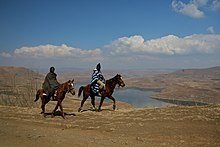Basotho
| 4 000 000(est. 2004)[1] | |
| 2 100 000(est. 2004)[2] | |
| Population totale | 7 000 000(est. 2004)[1] |
| Langues | sotho du Nord,sotho du Sud |
|---|---|
| Ethnies liées | Tswanas |
- 0–20 %
- 20–40 %
- 40–60 %
- 60–80 %
- 80–100 %
LesSothoouBasothosont unpeuple bantoud'Afrique australeétabli principalement enAfrique du Sudoù ils constituent l'un des plus importants groupes ethno-linguistiques[1],et auLesotho– l'ancienBasutoland– où ils sont très largement majoritaires (96,7 %[2]). Leur nombre total était estimé à près de 7 millions au début desannées 2000[1].
Ethnonymie
[modifier|modifier le code]Le singulier deBasothoestMosotho(respectivementBassoutoetMassouto).
Selon les sources on observe plusieurs variantes dans la façon française de rendre ces mots: Basotho, Basoto, Basouto, Bassouto, Basuto, Basutu, Sothos, Soto, Souto, Suthu, Suto, Sutu[3].
Langues
[modifier|modifier le code]On distingue les Basotho (parlant lesotho du Sud[4],auLesotho) desTswanas(parlant lesotho de l'Ouest[5],auBotswana) et des Sotho habitant les provinces du Nord de l'Afrique du Sud(Gauteng,LimpopoetMpumalangaparlant lesotho du Nord[6]).
Histoire
[modifier|modifier le code]La nation Basotho (habitant leLesothomoderne) émergea de la diplomatie deMoshoeshoe Ierqui réunit desclansdisparates d'origine Sotho qui avaient été dispersés au cours du début duXIXesiècle. Leur pays a été vu la première fois par des occidentaux en 1801 par les AnglaisTrutteretSomerville[Lequel?].
Mythologie
[modifier|modifier le code]Les Basotho ont leurs mythes et légendes. Un mythe célèbre est celui du héros appelé, selon les versions, Moshanyana ou Ditaolane. Un jour, un monstre terrifiant fit irruption dans un village des Basotho et dévora tous ses habitants. Seule une femme enceinte, qui s'était cachée dans un enclos à bestiaux, fut épargnée. La femme accoucha d'un guerrier déjà adulte et en armes, Moshanyana. Quand elle lui raconta ce qui s'était passé, Moshanyana partit sur le champ pour retrouver le monstre. Dans l'intervalle, ce dernier, alourdi par son repas et devenu plus gros, s'était coincé en essayant de passer un col de montagne. Moshanyana le retrouva et le tua, puis il lui ouvrit le ventre et en fit ressortir les villageois indemnes[7].
Notes et références
[modifier|modifier le code]- Funso S. Afọlayan,Culture and Customs of South Africa,Greenwood Publishing Group, 2004, p. 15(ISBN9780313320187)
- Lesotho (Université de Laval[1])
- SourceRAMEAU,BnF[2]
- (en)Fiche langue
[sot]dans la base de données linguistiqueEthnologue. - (en)Fiche langue
[tsn]dans la base de données linguistiqueEthnologue. - (en)Fiche langue
[nso]dans la base de données linguistiqueEthnologue. - Petit Larousse illustré des légendes et des mythes,Larousse, 2016,p.254 et 275.
Voir aussi
[modifier|modifier le code]Bibliographie
[modifier|modifier le code]- Sam Atkinson et Paula Regan (dir.),Petit Larousse illustré des légendes et des mythes,Paris, Larousse, 2016. (Première édition:Myths and Legends,Dorling Kindersley Publishing, 2009.)
- (en)Dan Bosko,Social organizational aspects of religious change among Basotho,New York University, 1983, 356 p. (thèse)
- (en)David Bellin Coplan,In the time of cannibals: the word music of South Africa's Basotho migrants,University of Chicago Press, Chicago, 1994, 300 p.(ISBN0226115747)
- (en)J. Dreyer, « The Basotho hut: from Late Iron Age to present », inSouth African journal of ethnology,16 (3),,p. 79-86
- (en)Jeff Guy et Motlatsi Thabane, « Basotho miners, oral history and worker's strategies », in Preben Kaarsholm (dir.),Cultural struggle and development in Southern Africa,Baobab Books,Harare;James Currey, Londres; Heinemann, Portsmouth, NH, 1991, p. 239-258
- (en)Myrtle Karstel,The Basotho blanket: borrowed but traditional,National Museum,Bloemfontein,1995, p. 194-223(ISBN1868470121)
- (en)Daniel P. Kunene,Heroic poetry of the Basotho,Clarendon Press, Oxford, 1971, 203 p.(ISBN0198151322)(compte-rendu en français[3])
- (en)Thomas Lesaoana Manyeli, « Religious symbols of the Basotho », in Mazenod Printing Works, Mazenod (Lesotho), 1992, 133 p.
- (en)Sindile Adelgisa Moitse,The ethno-musicology of the Basotho: a study of the entrenchment of music in Sotho cultural institutions,Institute of Southern African Studies,National University of Lesotho,Roma (Lesotho), 1990, 90 p. (bilingue)
- (en)'Makali Isabella Mokitimi, « Praise poetry: praise poetry of the Basotho », in Philip M. Peek,African folklore: an encyclopedia,Routledge, New York, 2004, p. 360-361
- (en)Hedley Sleath,A decade with the Basotho,Dept. of Public Relations and Communication of the Methodist Church of Southern Africa in co-operation with the Board of the Semonkong Methodist Hospital, Johannesburg, 1988, 114 p.(ISBN094745005X)
- (en)Gary Van Wyk, « The mural art of Basotho women (photo essay) », inAfrican arts(Los Angeles), 31 (3), été 1998, p. 58-65
- (en)Gary Van Wyk,African painted houses: Basotho dwellings of Southern Africa,Harry N. Abrams, New York, 1998, 168 p.(ISBN0810919907)
- (en)Robin E. Wells,An introduction to the music of the Basotho,Morija Museum and Archives, Morija (Lesotho), 1994, 338 p.(ISBN9991179372)
- E. Jacottet,Contes populaires des Bassoutos,Kraus Reprint, Nendeln, 1974, 292 p. (texte intégral de la première édition, E. Leroux, 1895, en ligne[4])
- Claude-Hélène Perrot,Les Sotho et les missionnaires européens au XIXesiècle,Université d'Abidjan, Abidjan, 1970, 185 p. (Thèse, Paris, 1963) (compte-rendu en ligne[5])
- Paul Ramseyer, « La circoncision chez les Bassoutos », inRevue d'ethnographie et des traditions populaires(Paris), 8 (33), 1928, p. 40-70
Filmographie
[modifier|modifier le code]- (en)The Color of Gold,documentaire de Don Edkins, Afrique du Sud et Lesotho, distr. Icarus Films, 1992.
- (en)Goldwidows: Women in Lesotho,documentaire de Don Edkins, Afrique du Sud et Lesotho, distr. Icarus Films, 1990.
Discographie
[modifier|modifier le code]- (en)Tswana and Sotho voices: Botswana, South Africa, Lesotho: 1951 '57 '59(collec. Hugh Tracey), International Library of African Music, Grahamstown, 2000
Articles connexes
[modifier|modifier le code]Liens externes
[modifier|modifier le code]- Eugène Arnaud Casalis,Les Bassoutos, ou, Vingt-trois années de séjour et d'observations au sud de l'Afrique,C. Meyrueis et Cie, Paris, 1859, 370 p.
- Frédéric Christol,Les Bassoutos,Plon, Paris, 1898, 32 p.
- Lesotho(Université de Laval)


